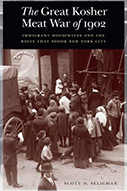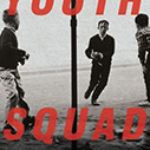The Great Kosher Meat War Of 1902: Immigrant Housewives And The Riots That Shook New York City

Author: Scott D. Seligman
Lincoln, NE: Potomac Books (c/o University of Nebraska Press), 2020. 312p.
Reviewer: Gerald W. McFarland | August 2021
On May 14, 1902, a sudden rise in the price of kosher beef triggered an angry grassroots response among Jewish housewives on Manhattan’s Lower East Side. Scott D. Seligman calls this The Great Kosher Meat War of 1902. At a mass meeting that assembled on the night of May 14th, these working-class immigrant women agreed to boycott kosher butcher shops in the district, and the next morning they set up picket lines outside the shops. Violence soon ensued. Customers who had entered the shops and bought meat had their purchases forcefully taken from them. Shop windows were smashed and shop interiors vandalized, the most common method being pouring kerosene on beef that was on display. Hundreds of police who were called to the scene dealt with the protestors harshly, beating them with nightsticks and arresting dozens. The boycotting women did not back off. More mass meetings were held and picketing continued. By early June the boycott’s devastating impact on the livelihoods of the district’s retail butchers led to a reduction in the price of retail beef and the end of the boycott.
Seligman skillfully outlines the key facts about these events and their aftermath. The boycott was initially led and populated by Jewish immigrant women, their efforts soon supplemented by male allies, many with experience in the labor movement. The Lower East Side’s retail butchers who, like their customers, were also Jews, were caught in a vise between angry housewives and the formidable price-setting power of local wholesale slaughterhouses and the monopolistic control over beef production exercised by six huge Midwestern corporations known collectively as the Beef Trust. During the weeks that the kosher meat boycott was in its most intense phase, the market hegemony of these corporations (led by industrial titans such as Gustavus Swift and Philip Armour) was itself being challenged by the Theodore Roosevelt administration’s legal assault on monopolistic practices, a parallel story that Seligman describes as the deep background to events on the Lower East Side of Manhattan.
In his closing chapters, Seligman concludes that the Lower East Side kosher beef boycott of 1902 had a long-lasting impact. Lower East Side immigrant women played major roles in several subsequent direct-action grassroots protests—a strike in 1904 to fight rising rents, another kosher meat protest in 1907, a second rent strike in 1907, and the well-known New York Shirtwaist Strike of 1909. The tactics employed in these protests echoed those of the kosher meat boycotters of 1902.
Seligman’s well-researched book offers a valuable window into the emergence of direct-action protest among immigrant women on Manhattan’s Lower East Side. In defending their families’ interests, the women boycotters displayed a high degree of intelligence, boldness, and militancy that set a new standard for activism among working-class women. The book includes numerous contemporary photographs that vividly document the boycotters in action and the urban milieu in which they conducted their protest.
Gerald W. McFarland, Professor of History Emeritus, University of Massachusetts Amherst


